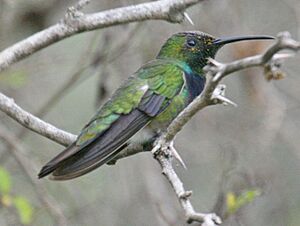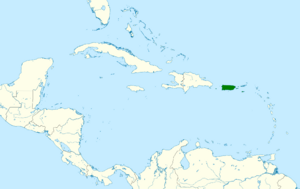Puerto Rican mango facts for kids
Quick facts for kids Puerto Rican mango |
|
|---|---|
 |
|
| Male | |
| Conservation status | |
| Scientific classification | |
| Genus: |
Anthracothorax
|
| Species: |
aurulentus
|
 |
|
| Synonyms | |
|
Anthracothorax dominicus aurulentus |
|
The Puerto Rican mango (Anthracothorax aurulentus) is a type of hummingbird. It lives on islands in the Caribbean Sea. You can find it in Puerto Rico, the British Virgin Islands, and the American Virgin Islands.
Contents
About the Puerto Rican Mango Hummingbird
How Scientists Classify This Bird
For many years, some scientists thought the Puerto Rican mango was a type of "Antillean mango" hummingbird. They saw it as a subspecies, which is like a special group within a species.
But in 2003, a group called BirdLife International decided it was its own separate species. They then called the "Antillean mango" by a new name, the Hispaniolan mango. Other big bird groups, like the American Ornithological Society, agreed in 2022. This means scientists now see the Puerto Rican mango as a unique kind of hummingbird.
What the Puerto Rican Mango Looks Like
The Puerto Rican mango is a small bird. It is about 11 to 12 centimeters (4.3 to 4.7 inches) long. Male birds weigh about 4.8 to 7.2 grams (0.17 to 0.25 ounces). Females are a bit lighter, weighing 4.0 to 6.4 grams (0.14 to 0.23 ounces).
Male birds have shiny bronze-green feathers on their backs. Their sides are green, and their bellies are dark brownish-gray. Their tails are also bronzy-green. Female birds have shiny bronze-green backs too. Their undersides are grayish, becoming very light white on their bellies. Their tails are brownish-gray with wide black marks near the end. The feathers on the very outside of their tails have white tips.
Where the Puerto Rican Mango Lives
You can find the Puerto Rican mango in Puerto Rico and on its nearby island, Culebra. It also lives on the British and American Virgin Islands. Sadly, it seems to have disappeared from the Puerto Rican island of Vieques.
These hummingbirds mostly live in low areas, below 250 meters (820 feet) high. They like to live in gardens and at the edges of forests.
Behavior of the Puerto Rican Mango
Bird Movements
The Puerto Rican mango stays in the same area all year round. It does not migrate to other places.
What the Puerto Rican Mango Eats
This hummingbird eats two main things: nectar from flowers and small bugs. Scientists do not know all the details about their eating habits yet.
They drink nectar from many different kinds of flowering plants. Male hummingbirds will protect areas that have lots of nectar-rich flowers. They usually catch insects while flying. They also find spiders on leaves and tree bark. These birds can look for food as high as 20 meters (66 feet) above the ground.
Reproduction and Life Cycle
Scientists have not studied the breeding habits of the Puerto Rican mango very much. Most of what we know comes from people observing them. It is thought that they might breed at any time of the year. In Puerto Rico, they might even breed twice a year.
Their nest is shaped like a cup. They build it from soft plant fibers and use spider silk to hold it together. They cover the outside with small pieces of lichen and tree bark. Nests are usually built in trees or bushes. In Puerto Rico, nests have also been found on things made by people, like power lines, antennas, and fences. A female hummingbird usually lays two eggs. The eggs hatch after about 15 days. The young birds are ready to fly about 22 to 25 days after they hatch.
Sounds the Puerto Rican Mango Makes
The Puerto Rican mango is thought to be a quiet bird. Scientists have not described its song. Its calls include a short sound like "tsip" repeated. It also makes a high-pitched, flowing trill sound.
Status of the Puerto Rican Mango
The IUCN, a group that checks on animals, says the Puerto Rican mango is a species of "Least Concern." This means it is not in danger of disappearing right now. However, we do not know how many of these birds there are, and their numbers seem to be going down. They are generally common in areas near the coast. But they have disappeared from some smaller islands offshore.



